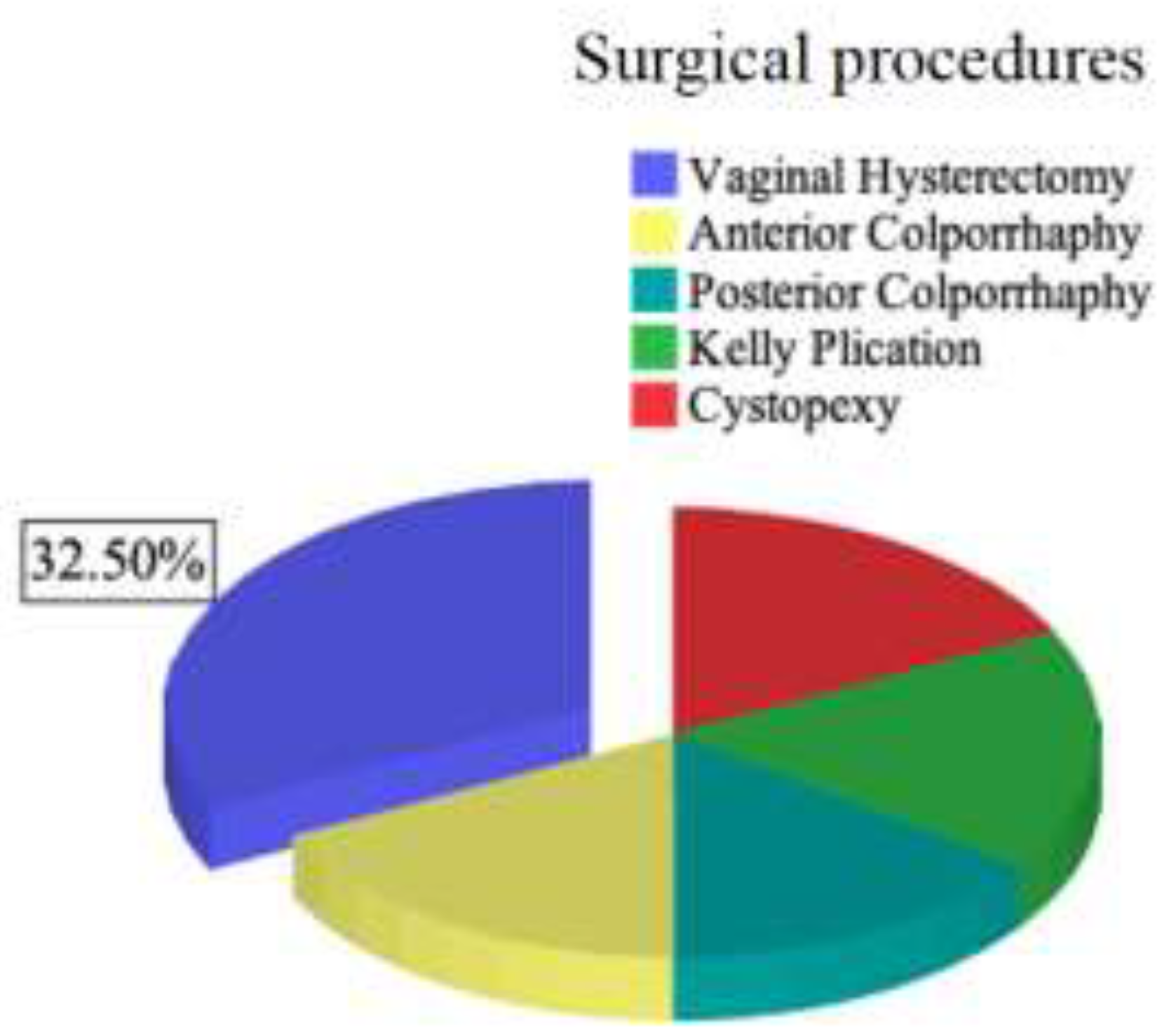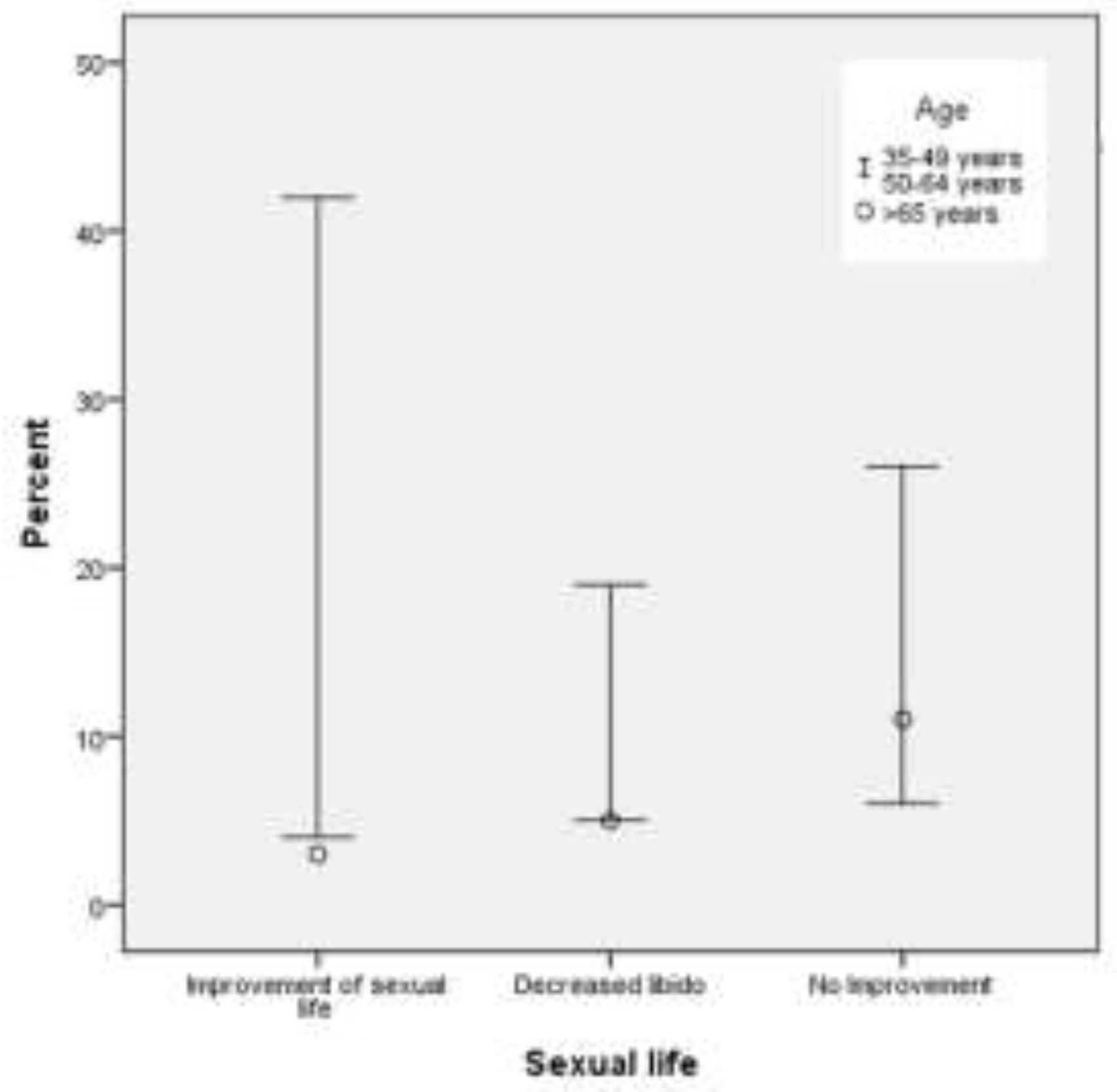The Quality of Sexual Life After Vaginal Surgical Interventions
Abstract
Introduction
Materials and Methods
Results
Discussions
Highlights
- ✓
- The malfunction of the supporting pelvic system generates signs and symptoms that require various surgical procedures.
- ✓
- Vaginal surgical interventions for genital prolapse or urinary incontinence do not lead to significant alteration of quality of sexual life in women.
Conclusions
Conflict of interest disclosure
Compliance with ethical standards
References
- Herzog, A.R.; Diokno, A.C.; Brown, M.B.; Fultz, N.H.; Goldstein, N.E. Urinary incontinence as a risk factor for mortality. J Am Geriatr Soc. 1994, 42, 264–268. [Google Scholar] [CrossRef] [PubMed]
- Yip, S.K.; Cardozo, L. Psychological morbidity and female urinary incontinence. Best Pract Res Clin Obstet Gynaecol. 2007, 21, 321–329. [Google Scholar] [CrossRef]
- Brown, J.S.; McGhan, W.F.; Chokroverty, S. Comorbidities associated with overactive bladder. Am J Manag Care. 2000, 6 (Suppl. S11), S574–S579. [Google Scholar]
- Ples, L.; Sima, R.M.; Stanescu, A.D.; et al. Transperineal Ultrasound Role for Pelvic Floor Dysfunction Evaluation. Proceeding of the paper for the 13th National Congress of Urogynecology, (UROGYN 2016; 2016; pp. 252–257. [Google Scholar]
- Serati, M.; Salvatore, S.; Uccella, S.; Nappi, R.E.; Bolis, P. Female urinary incontinence during intercourse: A review on an understudied problem for women's sexuality. J Sex Med. 2009, 6, 40–48. [Google Scholar] [CrossRef] [PubMed]
- Motofei, I.G. A dual physiological character for sexual function: The role of serotonergic receptors. BJU Int. 2008, 101, 531–534. [Google Scholar] [CrossRef]
- Schumpf, L.F.; Theill, N.; Scheiner, D.A.; Fink, D.; Riese, F.; Betschart, C. Urinary incontinence and its association with functional physical and cognitive health among female nursing home residents in Switzerland. BMC Geriatr. 2017, 17, 17. [Google Scholar] [CrossRef] [PubMed]
- Elia, G.; Bergman, J.; Dye, T.D. Familial incidence of urinary incontinence. Am J Obstet Gynecol. 2002, 187, 53–55. [Google Scholar] [CrossRef]
- Bălălău, D.O.; Sima, R.M.; Bacalbașa, N.; Banu, P.; Bălălău, C.; Pleș, L.; Stănescu, A.D. High-grade cervical dysplasia in pregnancy–psychological and medical challenges. J Mind Med Sci. 2017, 4, 24–30. [Google Scholar] [CrossRef]
- Wood, L.N.; Anger, J.T. Urinary incontinence in women. BMJ. 2014, 349, g4531. [Google Scholar] [CrossRef]
- Radosa, J.C.; Meyberg-Solomayer, G.; Kastl, C.; et al. Influences of different hysterectomy techniques on patients' postoperative sexual function and quality of life. J Sex Med. 2014, 11, 2342–2350. [Google Scholar] [CrossRef]
- Poenaru, M.O.; Sima, R.M.; Dan, D.; et al. Comparison Between Classical and Protetic Surgical Intervention for Pelvic Floor Dysfunctions and Urinary Stress Incontinence. Proceeding of the paper for the 13th National Congress of Urogynecology. 2016 (UROGYN 2016); pp. 258–261.
- Dhital, R.; Otsuka, K.; Poudel, K.C.; Yasuoka, J.; Dangal, G.; Jimba, M. Improved quality of life after surgery for pelvic organ prolapse in Nepalese women. BMC Womens Health. 2013, 13, 22. [Google Scholar] [CrossRef] [PubMed][Green Version]
- Motofei, I.G.; Rowland David LBaconi, D.L.; et al. Therapeutic considerations related to finasteride administration in male androgenic alopecia and benign prostatic hyperplasia. Farmacia. 2017, 65, 660–666. [Google Scholar]
- Lukacz, E.S.; Warren, L.K.; Richter, H.E.; et al. Quality of Life and Sexual Function 2 Years After Vaginal Surgery for Prolapse. Obstet Gynecol. 2016, 127, 1071–1079. [Google Scholar] [CrossRef]
- Schiavi, M.C.; DʼOria, O.; Faiano, P.; et al. Vaginal Native Tissue Repair for Posterior Compartment Prolapse: Long-Term Analysis of Sexual Function and Quality of Life in 151 Patients. Female Pelvic Med Reconstr Surg. 2018, 24, 419–423. [Google Scholar] [CrossRef] [PubMed]
- Schiavi, M.C.; Savone, D.; Di Mascio, D.; et al. Long-term experience of vaginal vault prolapse prevention at hysterectomy time by modified McCall culdoplasty or Shull suspension: Clinical, sexual and quality of life assessment after surgical intervention. Eur J Obstet Gynecol Reprod Biol. 2018, 223, 113–118. [Google Scholar] [CrossRef]
- Dimcevici Poesina, N.; Bălălău, C.; Bârcă, M.; et al. Testicular histopathological changes following sodium fluoride administration in mice. Rom J Morphol Embryol. 2013, 54, 1019–1024. [Google Scholar] [PubMed]
- Rahkola-Soisalo, P.; Altman, D.; Falconer, C.; Morcos, E.; Rudnicki, M.; Mikkola, T.S. Quality of life after Uphold™ Vaginal Support System surgery for apical pelvic organ prolapse-A prospective multicenter study. Eur J Obstet Gynecol Reprod Biol. 2017, 8, 86–90. [Google Scholar] [CrossRef]
- Motofei, I.G.; Rowland, D.L.; Popa, F.; et al. A Pilot Study on Tamoxifen Sexual Side Effects and Hand Preference in Male Breast Cancer. Arch Sex Behav. 2015, 44, 1589–1594. [Google Scholar] [CrossRef]
- Kowalik, C.R.; Lakeman, M.M.E.; de Kraker, A.T.; Roovers, J.P.W.R. Effects of mesh-related complications in vaginal surgery on quality of life. Int Urogynecol J. 2019, 30, 1083–1089. [Google Scholar] [CrossRef]
- Hokenstad, E.D.; El-Nashar, S.A.; Blandon, R.E.; et al. Health-related quality of life and outcomes after surgical treatment of complications from vaginally placed mesh. Female Pelvic Med Reconstr Surg. 2015, 21, 176–180. [Google Scholar] [CrossRef]
- Petcharopas, A.; Wongtra-Ngan, S.; Chinthakanan, O. Quality of life following vaginal reconstructive versus obliterative surgery for treating advanced pelvic organ prolapse. Int Urogynecol J. 2018, 29, 1141–1146. [Google Scholar] [CrossRef] [PubMed]
- Nguyen, L.N.; Gruner, M.; Killinger, K.A.; et al. Additional treatments, satisfaction, symptoms and quality of life in women 1 year after vaginal and abdominal pelvic organ prolapse repair. Int Urol Nephrol. 2018, 50, 1031–1037. [Google Scholar] [CrossRef] [PubMed]
- Weidner, A.C.; Barber, M.D.; Markland, A.; et al. Perioperative Behavioral Therapy and Pelvic Muscle Strengthening Do Not Enhance Quality of Life After Pelvic Surgery: Secondary Report of a Randomized Controlled Trial. Phys Ther. 2017, 97, 1075–1083. [Google Scholar] [CrossRef] [PubMed]


 |
© 2020 by the author. 2020 Maria Pană, Romina-Marina Sima, Oana-Denisa Bălălău, Anca-Daniela Stănescu, Liana Pleş, Mircea-Octavian Poenaru
Share and Cite
Pană, M.; Sima, R.-M.; Bălălău, O.-D.; Stănescu, A.-D.; Pleş, L.; Poenaru, M.-O. The Quality of Sexual Life After Vaginal Surgical Interventions. J. Mind Med. Sci. 2020, 7, 201-205. https://doi.org/10.22543/7674.72.P201205
Pană M, Sima R-M, Bălălău O-D, Stănescu A-D, Pleş L, Poenaru M-O. The Quality of Sexual Life After Vaginal Surgical Interventions. Journal of Mind and Medical Sciences. 2020; 7(2):201-205. https://doi.org/10.22543/7674.72.P201205
Chicago/Turabian StylePană, Maria, Romina-Marina Sima, Oana-Denisa Bălălău, Anca-Daniela Stănescu, Liana Pleş, and Mircea-Octavian Poenaru. 2020. "The Quality of Sexual Life After Vaginal Surgical Interventions" Journal of Mind and Medical Sciences 7, no. 2: 201-205. https://doi.org/10.22543/7674.72.P201205
APA StylePană, M., Sima, R.-M., Bălălău, O.-D., Stănescu, A.-D., Pleş, L., & Poenaru, M.-O. (2020). The Quality of Sexual Life After Vaginal Surgical Interventions. Journal of Mind and Medical Sciences, 7(2), 201-205. https://doi.org/10.22543/7674.72.P201205



